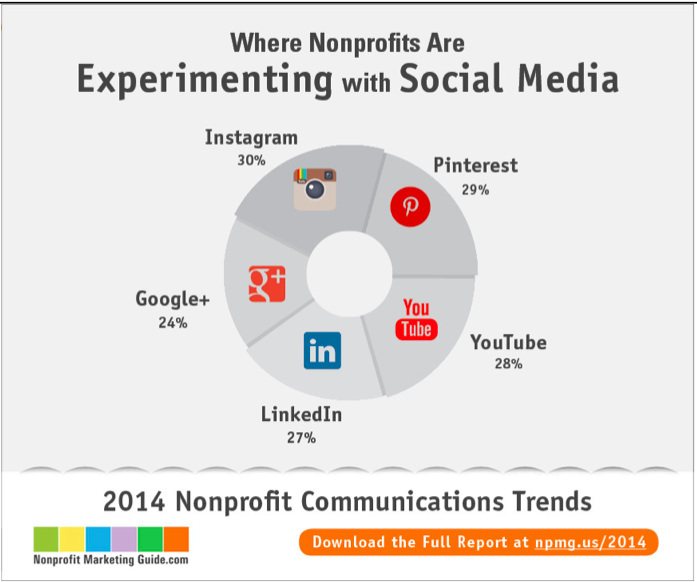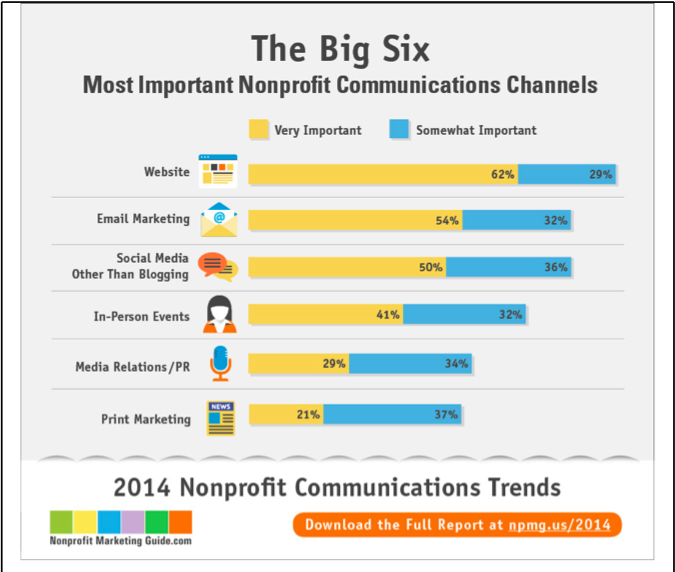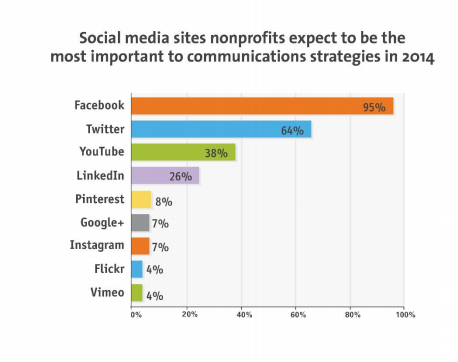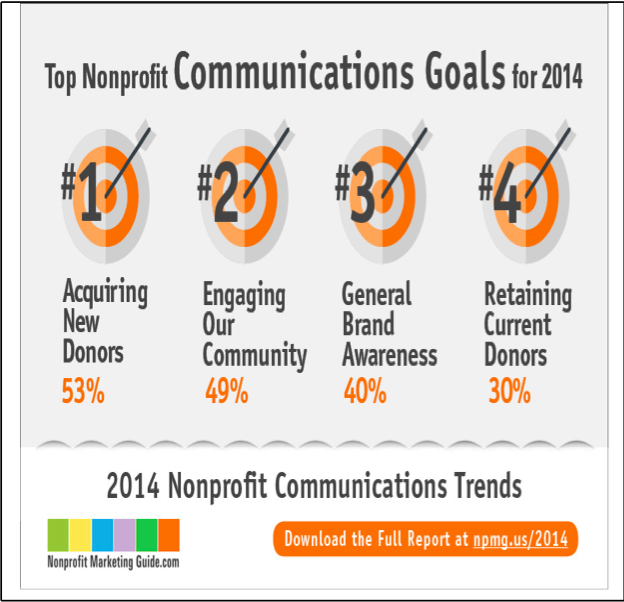Social media is the nonprofit sector’s most undervalued secret weapon, yet it has redefined the way modern marketing is conducted. The reason for all this untapped potential is not because social media is some giant secret, but rather nonprofit executives are still largely unfamiliar with what social media has to offer and how they can successfully implement those resources into their line of work. Developing new marketing strategies and designing quality content can take time away from the tried and true methods of traditional operations, and frankly, many nonprofits would prefer to wait to see results from others in the industry who have implemented social media strategies before taking their first steps; as a result, organizations are having to work more diligently in order to meet donor expectations.
The time to act is now; social media is the future of marketing and communication and by failing to implement new strategies to harness these incredible new resources, nonprofits are going to find it harder to achieve their growth potential and meet long-term goals. Taking the time and effort to implement a social media strategy will increase marketing success and promote a nonprofit’s cause to countless new potential volunteers and donors. If it’s still not clear whether or not social media is important in the nonprofit sector, here are 10 ways nonprofits can use social media to spread their message.
According to a survey done by the Non Profit Management Group, the number one communication goal of nonprofits in
2014 is to acquire new donors. While canvassing and making cold-calls calls have proven effective in some aspects, this form of fundraising is limited in the physical manpower of an organization. Social media allows nonprofits to implement fundraising campaigns encompassing a whole new set of prospective donors whom have not previously been obtainable.
Tools such as Facebook use third-party resources to help set up and advertise fundraising campaigns directly through their services. If a nonprofit already has a Facebook page for their organization, they can utilize these resources by promoting the fundraising campaign through their follower’s personal accounts. The followers will be able to actively participate in the process by seeing things such as fundraising timelines that will depict monetary goals and represent the proximity the goal is to being reached. Tools such as Facebook will also allow organizations to search and seek out new donors through their service so that they may expand on their volunteer base and operate a well-funded organization.
2. Engage Participation Through a Unique Online Identity
Volunteers and donors want to see a nonprofit actively promoting the cause that they so vehemently advocate. Social media allows nonprofits to highlight their activities and events through the sharing of photos and videos. The sharing up these visual updates not only lets volunteers and donors know that work is being done to promote the cause, but it helps to alter the image of a nonprofit by removing any corporate conception and instead Producing a personal identity that reflects on the organization. The most popular and services for photo and video sharing includes Facebook, Instagram, Pinterest, and YouTube. All of these services have smartphone apps and make them easy to access no matter where a nonprofit may be operating in the world. The best part of these services is that they make it easier to target certain audiences through the use of keywords and hash tags. These specific characteristics will direct users to a specific search query, and help a nonprofit’s marketing team tailor material to a desired target audience.
3. Build Brand Awareness Through Repetitive Exposure

Building brand awareness is so much easier when it comes to social media because of its ability to access so many different
types of people multiple times a day. When an individual is regularly exposed to the same image or logo, they are more likely to investigate it further and become familiar with what the organization is about.
The best way to go about building this brand awareness is to create uniformity across social media sites and print advertisement material. If an organization uses their logo or distinguishable characters and represents this image every time, there is a far better chance of building that familiarity and creative a relationship with that user. Nonprofits should also connect users with other ways to access the organization by providing links back to the nonprofits website and their other social media outlets. Facebook utilizes ‘tabs’ that make this easier, and creates the links an organization wishes to share at the top of a Facebook page directly next to their logo or profile picture.
4. Plan Events while Minimizing Costs
Nonprofit budgets are tight, and putting social media to work by sending out event invites and announcements related to projects can save organizations copious amounts of money and take the guesswork out of event planning. Facebook, Google+, and many other social media services provide the ability to create events and send out invitations directly to individual profiles or emails. From there, those profile owners can choose to either respond with an ‘attending,’ or ‘not attending’ response, and the nonprofit can plan the event with a better estimate as to the number of participants.
5. Advertise a Cause for the Price of Nothing
When a user is scrolling through his/her social media outlet, the first thing they are bound to see is an avatar or profile picture of a user or organization. By utilizing this feature and advertising a nonprofit logo or service project directly through this source, users will be likely to come across an organizations image or profile and dig deeper to find what it’s all about. Once a nonprofit’s social profile is opened, they have the ability to promote their ideas and mission statement to the full extent and advertise directly from this free service.
6. Reinforce a Mission
Drafting new content and sharing industry specific facts with an audience will keep users informed about the cause a nonprofit is working toward and become a reminder as to what everyone is working so hard to achieve. This will ensure that passion and activism is high and volunteers and donors continue to give what they can to the organization to promote the specific cause.
7. Start a Conversations to Advocate Change 
Change starts with a conversation, and the best way for a nonprofit to get a conversation going and promote their cause is to get in contact with those who share their same goals and values. Social media creates that platform for communication through comments and messages between users that creates an open dialogue between nonprofits, the followers, and each other.
Nonprofits should promote this dialogue by doing the following:
— End social media posts with an open ended question
— Create posts asking for a solution to a problem
— Respond to users who try to interact with the organization through comments or messages
8. Brainstorm Future Initiatives
Rather than gambling on success with future initiatives and marketing plans, social media creates a platform for nonprofits to conduct surveys and ask for individual opinions that can shape and develop the direction of an organization. Nonprofits can either make a survey through a third-party resource such as SurveyMonkey to share on Facebook, or they can produce a poll question directly through Facebook to analyze results. The quicker the survey is to access and answer, the more likely it is that the survey will receive a greater quantity of respondents.
9. Publicize Success and Achievement
Awards and recognitions not only speak to the success of a nonprofits management operations, but they also make volunteers and donors feel like they are a part of something special that they will continue to promote. Donors and volunteers want to be able to say that they had a role in the growth of the organization and feel vindicated that the money and work that they put into that nonprofit was well worth it. Showcasing these awards through social media outlets or linking users to articles online mentioning an organization will promote this idea of success and achievement and keep everyone reminded that the nonprofit represents a worthy cause.
10. Let Results Speak for Themselves 
Volunteers and donors want to see results, so why not let those who have been influenced by an organization speak for themselves? Social media allows users who have been positively affected by a nonprofit to share their experience and tell the world how it influenced their life directly on a social media profile. This keeps results visible and helps to build a positive reputation.
In addition to allowing those who have been helped by a nonprofit to post directly to a social media source, nonprofits can curate their own social media releases based upon print material receive or unique stories that they have come upon during their nonprofit work.
The benefits of marketing a nonprofit through the use of social media vastly outweigh the time and effort it takes to implement a marketing strategy and move away from traditional forms of brand outreach. That’s not to say that those traditional forms should be abandoned, but social media can compliment an organization’s marketing approach and expand outreach to a degree that was not previously obtainable. Nonprofits are now able to promote fundraising efforts and build a reputable brand by regularly interacting with their volunteers and donors without having to invest in costly advertising fees that took a hefty toll on the annual operation budget. These are just 10 ways nonprofits can use social media to spread their message, but the results are in and its clear the social media is the key to a successful nonprofit marketing campaign.
Image Credit: [Flickr/Stefan Sager]
Categories: Featured , Nonprofits , Social Good Marketing , Social Media , Strategy & Planning
Share






